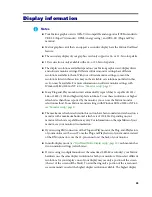
46
resolution available is the highest resolution supported by both monitors. If one of your
monitors supports a higher resolution, it may use display scaling to fill the entire screen.
For more information on what your monitors support, see their documentation.
!
You may experience problems viewing certain types of video (for example, DVD video).
If you experience this problem, try lowering your display settings (resolution, color
palette, and/or refresh rate). If you’re having problems viewing video with your
secondary display, try using your main display instead. For information on changing
display settings,
see “Display setup”, page 9
.
Maximum display resolution
Aspect ratio
Main display
*
Secondary display
*
4:3/5:4
(traditional)
2048 × 1536
1600 × 1200
16:9/16:10
(wide)
1920 × 1200
1600 × 1024
* With digital monitors, the maximum display resolution is 1280 × 1024.
Maximum vertical refresh rate (Hz)
*
Aspect ratio
Display
resolution
Main display
(360 MHz RAMDAC)
Secondary display
†
(230 MHz RAMDAC)
4:3/5:4
(traditional)
640 × 480
200
200
800 × 600
200
200
1024 × 768
160
160
1152 × 864
140
140
1280 × 1024
120
120
1600 × 1200
100
85
1800 × 1440
85
—
1920 × 1440
85
—
2048 × 1536
85
—
16:9/16:10
(wide)
856 × 480
200
200
1280 × 720
160
140
1600 × 1024
120
90
1920 × 1080
110
—
1920 × 1200
100
—
* Based on a monitor with a maximum horizontal refresh rate of 130 kHz
† Maximum refresh rates are attainable when using 8- or 16-bit color palettes.
Maximums may not be attainable at the highest display resolutions
with
a 24- or 32-bit color palette.
















































